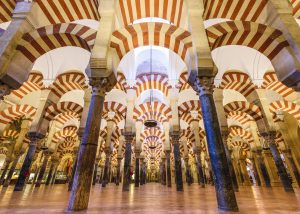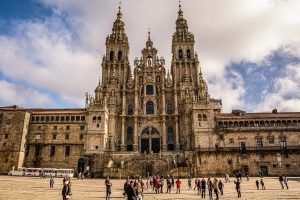The Arabs (“Moors”, “Saracenes”)
To put things into perspective man has to know about the past. From the Romans to the present day, Spain has played an important role in the progression of the Western World. InSpain.news gives a resume of the history of Spain based on several (scientific) sources. This is part 5 – the Arabs.
Arabs invade the Iberian peninsula
From 661, the Omajjads control the Islamic empire. Faithful to the command of Mohammed to spread Islam, they conquer the Roman provinces in North Africa. In 710, Berber king Tarif performs a raid trip on the southern tip of the Iberian Peninsula (Tarifa) and has the taste for more. A year later, 7,000 Islamic Berbers from north Africa, headed by their captain Tariq, cross the Gibraltar Straits (Jabal-i-Tariq, the rock of Tariq, spanned in Spanish to Gibraltar). The severely weakened Visigothic empire was not a worthy opponent, and the Visigoths fall.
Covadonga, the Christian kingdom of Asturias
The Arabs conquer Cadiz, Seville, Cordoba and Toledo within a year. In 713, the Damascus caliph calls for the establishment of Islam in the conquered areas on the Iberian peninsula. In 722, with a relatively small army, the Visigoths defeat the oppressive Moorish armies at Covadonga in the far north of Spain. This leads to the creation of the Christian kingdom of Asturias. Asturias is the only part of Spain that has always remained catholic; a reason why the Spanish crown prince carries the title “Principe de Asturias”.
The march of the “Moors” further north, (Frankish Gaul) ends after battles at Tours and Poitiers (732). Five years later, Charles Martel defeats Islamic armies again at Narbonne at which they withdraw south of the Pyrenees.
The Emirate of Cordoba

The emirate of Cordoba, established in 756, controls the entire Iberian peninsula, with exception of the northern area. Cordoba becomes a leading metropolis thanks to its cultural and scientific prosperity. In 756, Emir Abd ar Rahman I starts construction of the great mosque of Cordoba. Cordoba then has more than half a million inhabitants, two hundred thousand more than in the early 21st century.
The Moors mainly focus on the development of cities. The rural areas are left alone in the main, leaving them poor and underdeveloped. The northern border areas are relatively densely populated, and most of the time there is free trade between the Christian north and the Islamic part of Spain. The northern provinces, which cover the whole of the North, always remain independent.
The Catholic North
In the 8th century, the Principality of Asturias develops in the northwest. The Principality of Navarre (Basque country) emerges in the western Pyrenees and, from a fusion of several counties, Catalonia to the south of the Eastern Pyrenees. Charles the Great conquers these counties, deposing the Moors, in 801. From that point they remain in close contact with the Frankish empire.
Pilgrimage route Santiago de Compostela
The north develops through contacts with the Catholic Frankish Empire (Catalonia) and a large part of the Catholic world via the Pilgrimage Route to Santiago de Compostela, located in the extreme northwest of Spain. At the beginning of the 9th century, a hermit seemingly finds the material remains of the apostle Saint James (Santiago). From the 10th century, Santiago de Compostela becomes an increasingly important catholic pilgrimage town. The Moors attack the city and destroy the basilica.

This is rebuilt under French architecture (1078-1124). In the 11th century, Santiago de Compostela becomes the most important pilgrimage town in Europe and a source of inspiration for crusaders. The first English pilgrims arrive in Santiago around 1100. Santiago becomes the patron saint of the Reconquista in Spain.
Al-Andalus, the caliphate of Cordoba
The Arabs generally shows tolerance towards the conquered peoples, there is no extreme repression or pronounced oppression. There is a common trade language, but the original residents continue to speak their own language and continue to profess their own religion (Judaism, Christianity). The different groups retain their own identity, with assimilation limited, but there is also an overlap. Ideally, “Al Andalus” (not only the present Andalucia but the entire Muslim-controlled area on the Iberian Peninsula) is a melting pot of religious-ethnic groups. Islamic-Arab culture dominates but the populations for long periods coexist with a reasonable degree of mutual tolerance.
After Abd ar Rahman I (731-788), his descendants Abd ar Rahman II and III come to power. Abd ar Rahman III (912-961) declares himself Caliph and a large part of the Iberian Peninsula, the caliphate of Cordoba. After the Caliph’s death, the decay among its successors in the eleventh century entails a succession war that puts an end to political unity. The country divides into many smaller entities known as taifa’s (mostly consisting of a town with the surrounding land) that fight each other. Taifa is still used in modern Spanish mainly when referring to administrative organisation; “his taifa”: his own little kingdom.
Also read: Part 4, The Visigoths; part 3, the Romans; part 2, the Phoenicians; part 1, prehistory & antiquity


